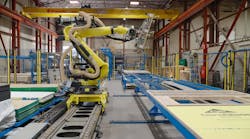After seeing numerous high-level examples of building failures due to air barrier defects, Florida-based Liberty Building Forensics Group (LBFG) is warning that air barrier goals set by architects aren't always achievable by contractors and can even lead to disaster.
Building moisture that leads to water damage and mold is supposed to be kept out by air barriers. However, accurate knowledge of how they function and how they can be built varies widely in the industry.
Additionally, architects often find it difficult to translate air barrier performance criteria into concrete design details, while contractors find it even more challenging to translate them into the construction itself.
Contractors don't know if they've met the design leakage criteria until the end of a project, since whole building air barrier testing can only be performed after a building is completed. By then, it is difficult to locate leak sites, and removal of completed construction is required to fix the problem.
"Building tightness is extremely important in increasing the drying potential of a wall," said LBFG Vice-President Richard Scott, AIA. "A well-constructed building with a good air barrier helps the HVAC system pressurize the building with conditioned air, which increases its drying effectiveness. HVAC systems in warm, humid climates need to pressurize properly, and a proper, continuous air barrier is necessary to accomplish this. After all, you can't pressurize a box with one side open."
This factor is especially important in buildings where a great deal of air movement occurs across areas of small square footage, such as hotel guest rooms, patient rooms in hospitals, high-rise and multi-family condos and apartments, assisted living, and nursing home units.
LBFG recommends having processes in place to increase the likelihood of achieving ultimate leakage criteria, such as quality control steps to identify workmanship issues, or mock-ups. Other keys are ensuring that air barriers are continuous while being installed, and being ready to implement contingency plans if design goals aren't met.
LBFG found that applying these strategies on a high-rise resort in Hawaii resulted in pinpoint precision of factors that were influencing the air barrier characteristics of this 500+-room complex. LBFG's testing and analysis led to implementation of a performance and prescriptive-based program to address deficiencies and achieve acceptable air barrier performance. This reduced the risk of a moisture and mold recurrence at the resort.









